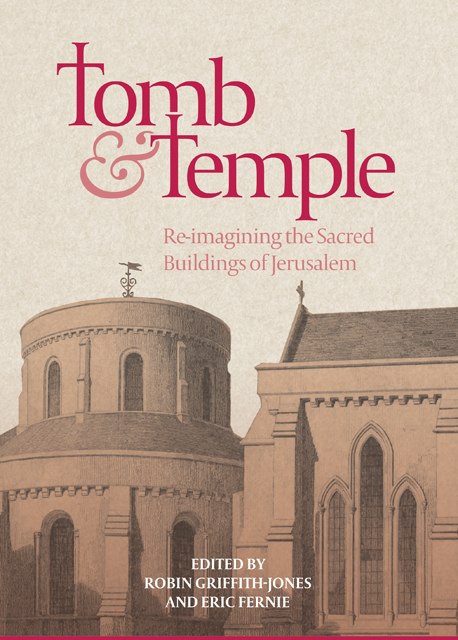Book contents
- Frontmatter
- Contents
- Illustrations
- Preface
- Contributors
- Abbreviations
- Editors’ Note
- Introduction
- Part I Re-presenting Jerusalem
- Part II The Church of the Holy Sepulchre
- Part III The Noble Sanctuary / The Temple Mount
- Part IV The Orthodox Churches
- Part V Round Churches in the West
- Appendix: The Knights’ Effigies: Newly Discovered Drawings by John Guillim, c. 1610
- Epilogue
- Index
- Already Published
15 - Arculf ’s Circles, Aachen’s Octagon, Germigny’s Cube: Three Riddles from Northern Europe
Published online by Cambridge University Press: 17 January 2023
- Frontmatter
- Contents
- Illustrations
- Preface
- Contributors
- Abbreviations
- Editors’ Note
- Introduction
- Part I Re-presenting Jerusalem
- Part II The Church of the Holy Sepulchre
- Part III The Noble Sanctuary / The Temple Mount
- Part IV The Orthodox Churches
- Part V Round Churches in the West
- Appendix: The Knights’ Effigies: Newly Discovered Drawings by John Guillim, c. 1610
- Epilogue
- Index
- Already Published
Summary
One set of drawings and two buildings from northern Europe, c. 680 to 850, raise an insistent question: what influenced the form of an imitation beyond the architecture and decoration of its prototype? This needs to be refined: in one vital case we are speaking of a supposed prototype. Charlemagne’s chapel at Aachen was linked with Solomon’s Temple by the panegyrists of his court, and has been linked with both the Temple and the Holy Sepulchre in one strand of modern scholarship. But any such link is uncertain. The uncertainty adds to Aachen’s value for our own enquiry. What architectural, political or theological features, c. 800, might have marked the chapel out, for whom, as being a copy or evocation of Jerusalem’s buildings at all?
Arculf, Iona And The Holy Places
In the winter of 679 to 680 Arculf, a bishop from Gaul, was in Jerusalem. On his homeward journey he was cast onto the west coast of Britain by a storm. He gave an account of his travels to Adomnán, abbot of Iona, who wrote down his visitor’s account and made a copy of Arculf’s own drawings of four sites: in Book 1 the Holy Sepulchre, the basilica on Mount Sion and the Imbomon or Church of the Ascension; and in Book 2 Jacob’s Well in Samaria. Adomnán writes that he questioned Arculf especially about the Sepulchre and the church built over it, ‘and Arculf drew its shape for me on a wax tablet’. Adomnán’s account of the Holy Places, De Locis Sanctis (hereafter DLS), survives in over twenty manuscripts. (Bede embedded in his History an abridgement of Adomnán’s account of the places of Christ’s own life, and reworked DLS into his own work of the same name.) At least nine known manuscripts preserve Adomnán’s plans.
In the rotunda, wrote Adomnán, ‘three walls rise from the foundations, and the distance between one wall and the next is about the width of a street’ (DLS 1.2.3). We reproduce the plan in the Vienna MS [Colour Pl. XXXII]. The drawings’ division of space, as defined by the rings of colours and lines, is not obvious. Heitz read them as follows.
- Type
- Chapter
- Information
- Tomb and TempleRe-imagining the Sacred Buildings of Jerusalem, pp. 301 - 328Publisher: Boydell & BrewerPrint publication year: 2018

